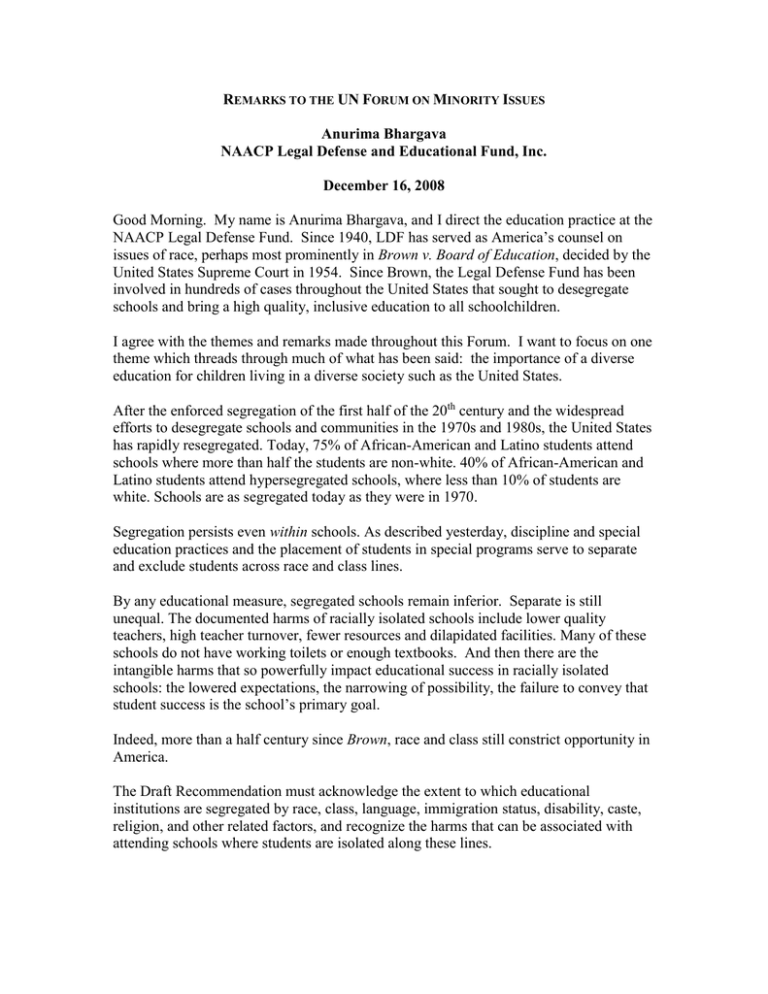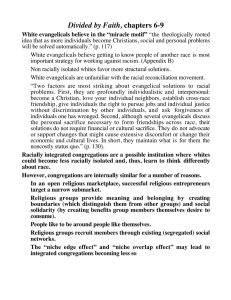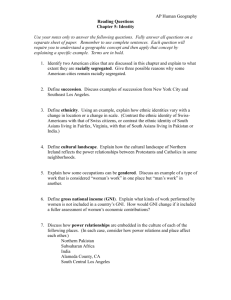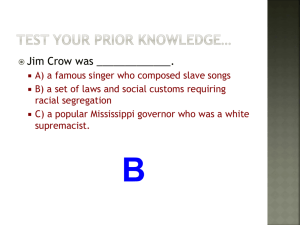R UN F M
advertisement

REMARKS TO THE UN FORUM ON MINORITY ISSUES Anurima Bhargava NAACP Legal Defense and Educational Fund, Inc. December 16, 2008 Good Morning. My name is Anurima Bhargava, and I direct the education practice at the NAACP Legal Defense Fund. Since 1940, LDF has served as America’s counsel on issues of race, perhaps most prominently in Brown v. Board of Education, decided by the United States Supreme Court in 1954. Since Brown, the Legal Defense Fund has been involved in hundreds of cases throughout the United States that sought to desegregate schools and bring a high quality, inclusive education to all schoolchildren. I agree with the themes and remarks made throughout this Forum. I want to focus on one theme which threads through much of what has been said: the importance of a diverse education for children living in a diverse society such as the United States. After the enforced segregation of the first half of the 20th century and the widespread efforts to desegregate schools and communities in the 1970s and 1980s, the United States has rapidly resegregated. Today, 75% of African-American and Latino students attend schools where more than half the students are non-white. 40% of African-American and Latino students attend hypersegregated schools, where less than 10% of students are white. Schools are as segregated today as they were in 1970. Segregation persists even within schools. As described yesterday, discipline and special education practices and the placement of students in special programs serve to separate and exclude students across race and class lines. By any educational measure, segregated schools remain inferior. Separate is still unequal. The documented harms of racially isolated schools include lower quality teachers, high teacher turnover, fewer resources and dilapidated facilities. Many of these schools do not have working toilets or enough textbooks. And then there are the intangible harms that so powerfully impact educational success in racially isolated schools: the lowered expectations, the narrowing of possibility, the failure to convey that student success is the school’s primary goal. Indeed, more than a half century since Brown, race and class still constrict opportunity in America. The Draft Recommendation must acknowledge the extent to which educational institutions are segregated by race, class, language, immigration status, disability, caste, religion, and other related factors, and recognize the harms that can be associated with attending schools where students are isolated along these lines. Second, since Brown, research and experience have demonstrated that to promote social cohesion in a diverse society such as the United States, it is important that students of all racial backgrounds attend schools that are racially and economically diverse. Students who attend racially diverse schools are less likely to develop prejudice or stereotypes against students or other racial groups, more likely to have friends and develop relationships across race and class lines, and more likely to live and work in integrated settings. In other words, integrated schools lead to integrated neighborhoods. The Draft Recommendation should note that in a racially and ethnically diverse nation such as the United States, the schools should also be racially and ethnically diverse. Third, education is not an abstract concept. It seeks to serve students and the societies where they live. Efforts to promote integration must take account of the identity, status and experience of the minority group. Suppression of identity cannot be a prerequisite to integration. Social cohesion requires recognition of identity along racial, religious, linguistic, and caste lines. The Draft Recommendation should indicate that efforts to promote integration and social cohesion should be conscious of and properly take account of race, language, immigration status, religion, caste and other factors that have underlied segregation. In addition, states must not prevent schools and communities from considering race, class and other factors in their desegregation strategies and efforts to promote diverse schools and communities. To realize the hope and promise of Brown – of a democracy that works for all schoolchildren, of a nation that recognizes education as the foundation of our citizenry and as the engine that prepares our children to live, work and play together in the future – the State must continue to support efforts to bring down the walls between communities.



